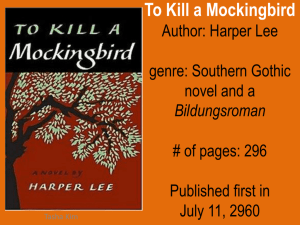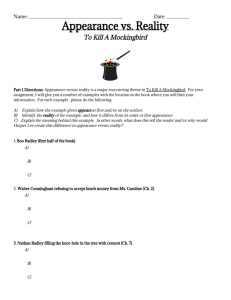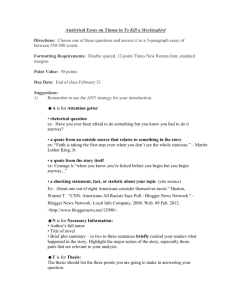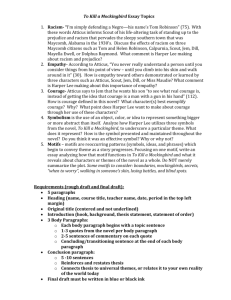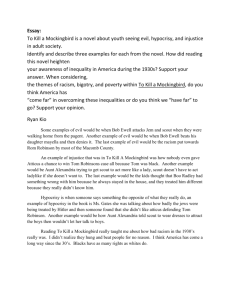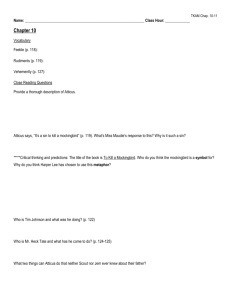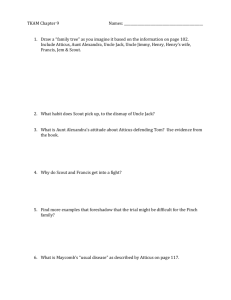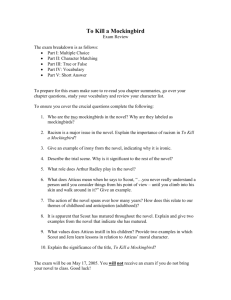To Kill a Mockingbird
advertisement
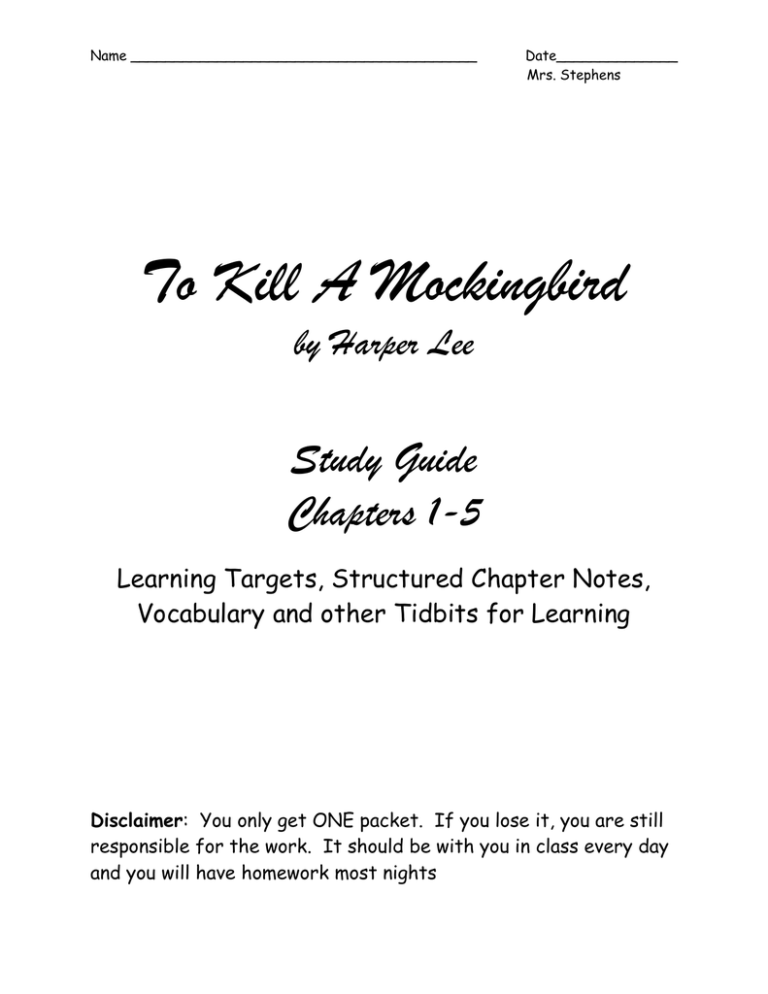
Name ________________________________________ Date______________ Mrs. Stephens To Kill A Mockingbird by Harper Lee Study Guide Chapters 1-5 Learning Targets, Structured Chapter Notes, Vocabulary and other Tidbits for Learning Disclaimer: You only get ONE packet. If you lose it, you are still responsible for the work. It should be with you in class every day and you will have homework most nights 2 To Kill a Mockingbird: A Unit of Study Unit Guiding Questions - How does taking a stand in small ways show integrity? - Is it worth taking a stand for one’s self? For others? Unit Big Ideas - Authors use the structure of texts to create style and convey meaning. - Authors use allusions to layer deeper meaning in the text. Content Connections - Theme 1: Individual Development and Cultural Identity o The role of social, political, and cultural interactions supports the development of identity. o Personal identity is a function of an individual’s culture, time, place, geography, interaction with groups, influences from institutions, and lived experiences. - Theme 5: Development and Transformation of Social Structures o Role of social class, systems of stratification, social groups, and institutions o Role of gender, race, ethnicity, education, class, age, and religion in defining social structures within a culture o Social and political inequalities o Expansion and access of rights through concepts of justice and human rights Long Term Learning Targets Addressed (Based on NYSP12 ELA CCLS) - I can cite text-based evidence that provides the strongest support for my analysis of literary text. (RL.8.1) - I can effectively engage in discussions with diverse partners about eight-grade topics, texts and issues. (SL.8.1) - I can analyze the impact of word choice on meaning and tone (analogies or allusions). (RL.8.4) Central Texts - “I Have a Dream” – Martin Luther King (1963) - “Equal Rights for Women” – Shirley Chisholm (1969) - “Ain’t I a Woman?” – Sojourner Truth (1864) - To Kill a Mockingbird – Harper Lee (1982) - “Those Winter Sundays” – Robert Hayden (1966) - “Incident” – Countee Cullen (1925) - “Solitude” – Ella Wheeler Wilcox (1883) 3 Story Impressions Read the following quotes from the novel, To Kill A Mockingbird. Think about what this novel may be about. “I maintain that the Ewells started it all…” “…it really began with Andrew Jackson.” “Maycomb was an old town…” “People moved slowly then.” “Maycomb County had recently been told it had nothing to fear but fear itself.” Pre-reading Wonder: Based on the phrases and lines from the opening pages of the novel, what do you wonder about this novel? What do you think this novel is going to be about? ___________________________________________________________________ ___________________________________________________________________ ___________________________________________________________________ ___________________________________________________________________ ___________________________________________________________________ ___________________________________________________________________ ___________________________________________________________________ ___________________________________________________________________ Chapter 1 Supporting Learning Targets for Chapter 1 - I can use the strongest evidence from To Kill A Mockingbird in my understanding of Chapter 1. - I can participate in discussions about the text with a partner, small group and the whole class. I can analyze the impact of allusions to world events in To Kill A Mockingbird. 4 Chapter 1 Vocabulary Word and Page Number assuaged (3) “the disturbance” (4) ambled (5) vague (6) optimism (6) satisfactory (6) routine contentment (8) malevolent (8) phantom (8) stealthy (9) alien (9) Definition Context Clues: How did you figure out this word? 5 Chapter 1 Homework Questions 1. What is the gist of what you read? (Remember “gist”? Hint… brief summary… or “essence” of what you read…) 2. Based on your reading of Chapter 1, how do Jem, Scout, and Dill describe Boo Radley? Use the best evidence from the novel to support the description. Remember to include page numbers and quotes around any phrases that are taken from the text. Chapter 2 Supporting Learning Targets for Chapter 2 - I can analyze the narrative structure of chapter 2. - I can objectively summarize chapter 2. - I can deepen my understanding of key words using vocabulary squares. - I can identify the strongest evidence in chapter 2 that shows why characters take a stand. 6 Chapter 2 Vocabulary Word and Page Number meditating (17) illicitly (17) sentimentality (19) vexations (21) sojourn (22) Definition Context Clues: How did you figure out this word? 7 Chapter 2 Questions 1. What is the gist of Chapter 2? 2. Why does Scout stand up for Walter? What does this say about her character? Use evidence from the text to support your answer. PASATFWOT Atticus Finch Physical Appearance Speech Actions Thoughts/Feelings What Others Think 8 What type of character is Atticus? How do you know? Use specific evidence from the text. Connotation versus Denotation We all know that words can have multiple meanings. The denotation of a word means the dictionary definition of a word. The connotation of a word is the emotional meaning behind a word. For example: The word “home” Denotation: a dwelling or place of residence Connotation: the place where a person feels safe or secure Let’s look at some of our vocabulary words. We already know the denotation of the words, so let’s decide if the connotation is positive or negative. Place a + next to the positive words and a – next to the negative words. Word List malevolent phantom satisfactory routine contentment stealthy alien meditating illicitly sojourn ambled vexations assuaged 9 Chapter 2 Homework Write a summary of chapter 2. ___________________________________________________________________ ___________________________________________________________________ ___________________________________________________________________ ___________________________________________________________________ ___________________________________________________________________ ___________________________________________________________________ ___________________________________________________________________ ___________________________________________________________________ ___________________________________________________________________ ___________________________________________________________________ ___________________________________________________________________ ___________________________________________________________________ ___________________________________________________________________ ___________________________________________________________________ 10 Text Dependent Questions Chapter 2 (pages 19-22) Text Dependent Questions Based on the text, what does the word “delegation” mean? Why might Lee describe the group of students as a “delegation”? Why is Scout the person who is chosen to explain things to Miss Caroline? Why does Lee include the information on Mr. Cunningham’s dealings with Atticus in the middle of the classroom scene? Why does Miss Caroline say, “You’re starting off on the wrong foot in every way, my dear”? What does Scout’s stand reveal about her personality or character? Explain. Response using the strongest evidence from the text Multiple Choice Question Practice Reread page 21 to answer these questions. 1. Based on chapter 2, what word is closet in meaning to the word “mortification” (21)? a. Silliness b. Humiliation c. Hatred d. Seriousness 2. Atticus’ statement, “Jem’s definitions are very nearly accurate sometimes” (21) is meant to create what tone? a. Suspense b. Sentimentality c. Humor d. Seriousness 11 Chapter 3 Supporting Learning Targets for Chapter 3 - I can continue to deepen my vocabulary knowledge using vocabulary squares. - I can support my inferences about chapter 3 with the strongest evidence from the text. - I can evaluate the similarities and differences between the novel and the film version of To Kill a Mockingbird. - I can analyze how the author draws on the theme of the Golden Rule in chapter 3. Chapter 3 Vocabulary Word and Page Number erratic (24) tranquility (24) contemptuous (27) compromise (31) concessions (31) Definition Context Clues: How did you figure out this word? 12 1. What is the gist of what you read? 2. Who takes a stand in this chapter? Why does this person take a stand? Using the text, explain your answer. The Golden Rule The “Golden Rule” is a philosophy found in cultures and religions around the world. In your own words, what is the Golden Rule? ___________________________________________________________________ ___________________________________________________________________ Give an example of the Golden Rule from To Kill a Mockingbird. 13 Text to Film Comparison Scene Similarities Differences Page 29 – “Something wrong Scout?” to “I never went to school.” Chapter 4 Supporting Learning Targets for Chapter 4 - I can support my inferences about chapter 4 with the strongest evidence from the text. - I can summarize chapter 4. - I can analyze how the author draws on the theme of the Golden Rule. - I can use context clues to determine the meaning of phrases in chapter 4. Chapter 4 Vocabulary Word and Page Number auspicious (32) opposition (32) Definition Context Clues: How did you figure out this word? 14 impulse (33) ethical (35) dreary (36) 1. What is the gist of what you read? 2. Atticus says, “You never really understand a person until you consider things from his point of view… until you climb into his skin and walk around in it” (chapter 3, page 30). How is this advice taken or ignored in this chapter? Use the strongest evidence from the novel in your answer. 15 “Golden Rule” in Karen Armstrong’s TED Talks Note Catcher What does Karen Armstrong say is central to all of the world’s religions? What is compassion? According to Armstrong, how are compassion and the Golden Rule related? What evidence from Armstrong’s speech suggests that she might agree with Atticus’s advice to Scout? (The quote about not understanding a person unless you walk around in their skin.) How does the “ethical culture” of Jem and Scout illustrate the idea of treating others the way you want to be treated? Why is “finders keepers” different with money? 16 Chapter 4 Close Reading Note Catcher Why does Lee call it a “melancholy little drama” Why do the children actually “know” about the Radleys? Are Jem, Scout, and Dill treating the Radleys with compassion? Explain. 17 Chapter 5 Supporting Learning Targets for Chapter 5 - I can deepen my understanding of key words by engaging in Quiz-Quiz-Trade. - I can support my inferences using strong evidence from the text. - I can determine the figurative meanings of words and phrases. Chapter 5 Vocabulary Word and Page Number benign (42) tacit (42) cordiality (43) benevolence (43) morbid (43) edification (49) Definition Context Clues: How did you figure out this word? 18 Text Dependent Questions 1. Reread the middle of page 43. Why does Miss Maudie say Scout is being morbid? 2. Reread the top of page 44. What does “the best defense… was a spirited offense” mean? 3. Reread the middle of page 45. What does “The Bible in the hand of one man is worse than a whiskey bottle in the hand of… your father” mean? 4. Reread the top of page 46. What does Scout mean when she says, “Atticus don’t ever do anything to Jem and me that he don’t do in the yard”? How does this draw on the Golden Rule theme? 19 Stop Tormenting the Man! Do a QuickWrite to address the following prompt: “I’m going to tell you something and tell you one time: stop tormenting that man” (49). What does this statement show about Atticus’s belief in the Golden Rule? What does this statement show about Atticus’s character? Use the text to support your answer. ___________________________________________________________________ ___________________________________________________________________ ___________________________________________________________________ ___________________________________________________________________ ___________________________________________________________________ ___________________________________________________________________ ___________________________________________________________________ ___________________________________________________________________ ___________________________________________________________________ ___________________________________________________________________ ___________________________________________________________________ ___________________________________________________________________ ___________________________________________________________________ ___________________________________________________________________ ___________________________________________________________________ ___________________________________________________________________

